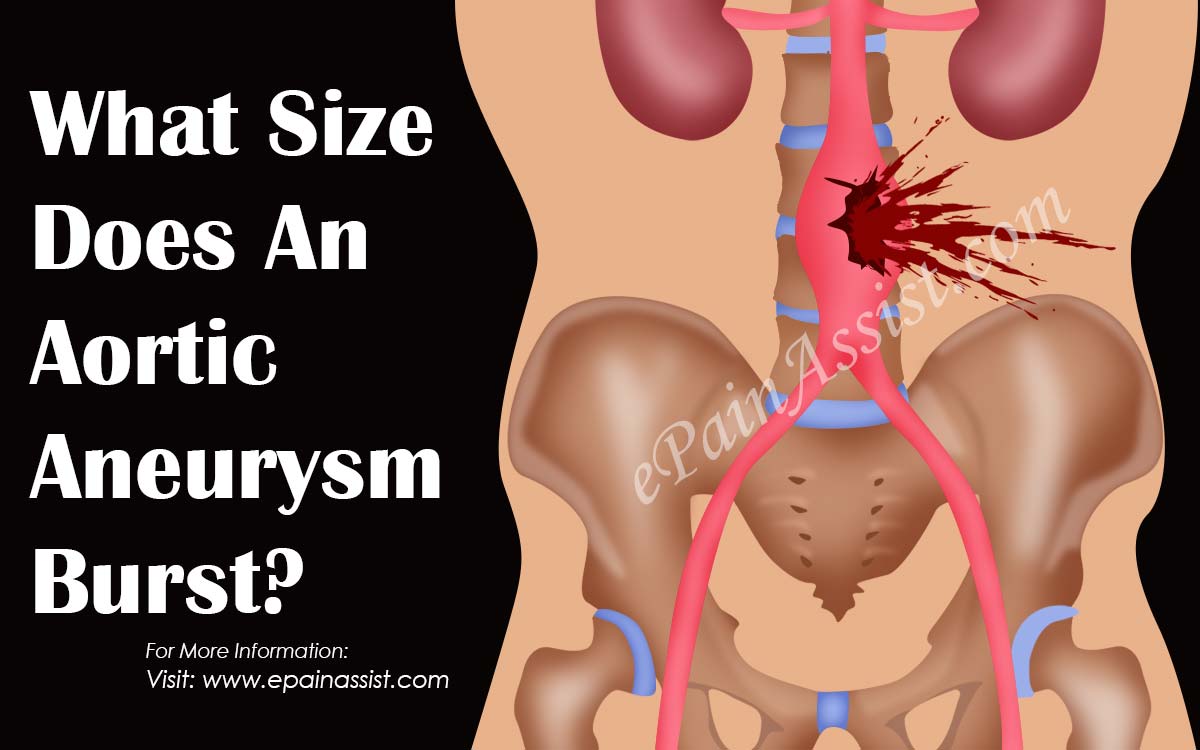Abdominal Aortic Aneurysm takes place whenever walls of main blood vessel in humans responsible for carrying the blood away from their heart i.e. aorta dilate or bulge. Aneurysm may takes place in almost every area present in aorta, but abdominal area is the common one.
Intact form of AAA i.e. abdominal aortic aneurysms in general does not create any form of health issue. However, large size of AAAs may rupture or burst and cause heavy bleeding in the abdominal area. Ruptured form of AAA thus forms a surgical emergency that requires medical treatment immediately. Blood close from any AAA rarely may break loose as well as lodge within the arteries of the patients’ legs resulting in the blockage of blood circulation and severe as well as sudden leg pain.

What Size Does An Aortic Aneurysm Burst?
Risk related to the burst or rupture of small aneurysms i.e. small than 4cm is relatively low than the rupture risk associated with any large aneurysm of more than 6cm. Along with the size, AAA rupture risk depends on the rate, by which aneurysm expands. Evidences have suggested that expansion of aneurysms takes place at the average rate from 0.3cm to 0.4cm yearly and tends to expand at the fastest rate as compared to any small aneurysm.
Risk of aneurysm rupture annually depends on its specific size, according to which-
- Less than diameter of 4cm has a risk of less than 1 among 200 in total
- Diameter between 4cm and 4.9cm have risk between 1 in total 200 and 1 in total 20
- Diameter between 5cm and 5.9cm have risk between 1 in total 30 and 1 in total 7
- Diameter between 6cm and 6.9cm have risk between 1 in total 10 and 2 in total 10
- Diameter between 7cm and 7.9cm have risk between 2 in total 10 and 4 in total 10
- Diameter of 8cm or higher than that have risk between 3 in total 10 and 5 in total 10.
You may even observe a huge variability in the expansion rate among different patients and for a specific patient in different years. Aneurysms expanding in a rapid way for instance of higher than 0.5cm for more than 6 months may involve relatively higher risk related to rupture. Most of the patients have relatively longer periods with lesser changes in the size of aneurysm.
However, a few forms of aneurysms because of unclear reasons remain fixed in their sizes for a specified time and later on, undergo with rapid burst. Enlargement in rupture or bulge tends to become highly rapid in smokers, while remain less rapid in diabetes mellitus patients. Until now, quitting cigarette smoking has proved to be the best and known way to reduce the problem of aneurysm enlargement.
Other Related Complications with Aorta Aneurysm
The situation of aortic aneurysm burst depends on several other related complications along with the ones mentioned before in the blog post. These are
- Inflammatory type of aneurysm, inflammation and swelling of the aneurysm wall leading to severe abdominal pain
- Aortovenous fistula, popularly known as the abnormal connection presents in between a vein and an aorta.
- Primary form of aortoentric fistula or an abnormal connection in between the bowel and the aorta
- Thromboembolism i.e. debris or blood clots from AAA that causes blockage in the blood flow into the legs
- Infected form of aneurysm
Each of these complications mentioned here are of limb as well as life-threatening ones and when doctors diagnose them, they indicate for the requirement of repair or surgery.
- Mayo Clinic. (2021, May 12). Abdominal Aortic Aneurysm. Mayo Clinic. https://www.mayoclinic.org/diseases-conditions/abdominal-aortic-aneurysm/symptoms-causes/syc-20350688
- Johns Hopkins Medicine. (n.d.). Abdominal Aortic Aneurysm. Johns Hopkins Medicine. https://www.hopkinsmedicine.org/health/conditions-and-diseases/abdominal-aortic-aneurysm
Also Read:
